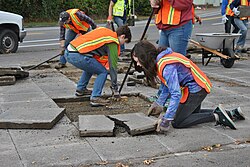Engineering:Depaving
Depaving, also known as desealing, is the act of removing impermeable surfaces such as parking lots and replacing with a permeable surface, especially green space.[1][2] Depaving can help manage stormwater runoff, ensuring that runoff is less polluted.[3]
The Depave Portland group in Portland, Oregon , United States says that it has depaved more than 70 parking lots and removed 150,000 square feet (14,000 m2) of paving since it was founded in 2008.[4] Some cities, including Portland, charge impervious pavement fees to cover the cost of dealing with runoff, which incentivizes depaving.[2] Eindhoven, Netherlands depaved parts of its area.[5] The city of Leuven, Belgium is planning depaving as part of its Leuven2050 plan to become carbon-neutral and combat the urban heat island effect.[6][7] Other motivations for depaving include providing habitat for wildlife,[8] combating climate change or increasing quality of life by replacing underutilized paved areas with green space.[1] A 2020 study found that depaving had high effectiveness for increasing groundwater replenishment.[5]
According to a 2016 study by the Transportation Research Board of the National Academies, depaving is common on rural roads as a cost-saving measure due to the high cost of maintaining paved surfaces.[9]
References
- ↑ 1.0 1.1 Garda, Emanuele (2019). "Let's get dirty! Le azioni di depaving dei suoli urbani per la multifunzionalità degli spazi sottoutilizzati" (in it). Altre Modernità 2019: NUMERO SPECIALE: Scrivere la terra: 164–178. doi:10.13130/2035-7680/12150. ISSN 2035-7680. https://riviste.unimi.it/index.php/AMonline/article/view/12150.
- ↑ 2.0 2.1 Douglas, Ian; Anderson, P. M. L.; Goode, David; Houck, Michael C.; Maddox, David; Nagendra, Harini; Tan, Puay Yok (2020). "Depaving" (in en). The Routledge Handbook of Urban Ecology. Routledge. ISBN 978-0-429-01526-7.
- ↑ "Over-paved? Group reduces impervious surfaces in Portland" (in en). Nonpoint Source News-notes (Terrene Institute). 2004. https://books.google.com/books?id=CSEWxK5PUfgC&dq=depaving&pg=RA12-PT2.
- ↑ "Depaving Paradise: Grassroots Portland Group Reclaims Parking Lots by Hand". Streetsblog USA. 12 June 2019. https://usa.streetsblog.org/2019/06/12/depaving-paradise-grassroots-portland-group-dismantles-parking-lots-by-hand/.
- ↑ 5.0 5.1 Augusto, Bruno; Roebeling, Peter; Rafael, Sandra; Ferreira, Joana; Ascenso, Ana; Bodilis, Carole (2020). "Short and medium- to long-term impacts of nature-based solutions on urban heat". Sustainable Cities and Society 57: 102122. doi:10.1016/j.scs.2020.102122. https://library.wur.nl/WebQuery/wurpubs/562909.
- ↑ "Leuven 2030 - Roadmap 2025 · 2035 · 2050" (in nl). https://roadmap.leuven2030.be/groene-en-veerkrachtige-ruimte.
- ↑ Daunton, Nichola (16 June 2022). "More people cycle than drive in this 'forward-thinking' European city" (in en). euronews. https://www.euronews.com/green/2022/06/16/leuven-this-forward-thinking-city-has-banned-cars-from-its-centre.
- ↑ Brears, Robert C. (2018) (in en). Blue and Green Cities: The Role of Blue-Green Infrastructure in Managing Urban Water Resources. Springer. p. 52. ISBN 978-1-137-59258-3. https://books.google.com/books?id=QwtQDwAAQBAJ&dq=depaving&pg=PA52.
- ↑ Truscello, Michael (1 September 2020) (in en). Infrastructural Brutalism: Art and the Necropolitics of Infrastructure. MIT Press. p. 255. ISBN 978-0-262-53904-3.
 |


